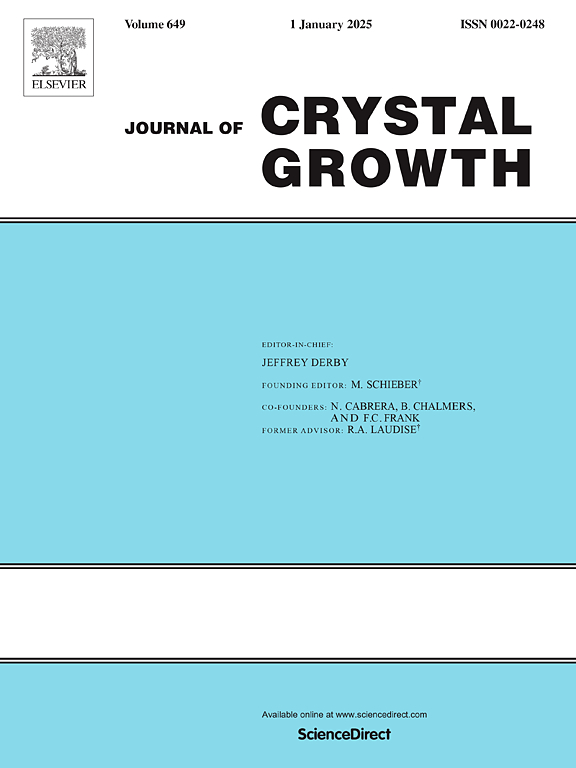Crystallization agents modifying conversion of phosphogypsum to α-hemihydrate gypsum: Effects of the charge and molecular polarity of carbon-based oxygen atoms
IF 1.7
4区 材料科学
Q3 CRYSTALLOGRAPHY
引用次数: 0
Abstract
To promote the resource utilization of phosphogypsum (PG) and reduce environmental pollution, this study utilizes the autoclave method with various organic acids and their sodium salts as crystallization agents to convert PG into α-hemihydrate gypsum (α-HH). The study investigates the effects and mechanisms of these crystallization agents on the crystal morphology and strength of α-HH using X-ray diffraction, X-ray photoelectron spectroscopy (XPS), Fourier transform infrared spectroscopy, scanning electron microscopy (SEM), zeta potential measurements, and molecular dynamics simulations. The results indicate that adding various organic acids and their sodium salts as crystallization agents can effectively regulate the strength and crystal morphology of the α-HH obtained from PG to reduce the aspect ratio of the α-HH crystals. Sodium citrate demonstrated the optimal efficacy as a crystallization agent in controlling the crystal morphology of α-HH. Reducing the aspect ratio to 1.25:1. The absolute dry compressive strength increased to 40.3 MPa when sodium citrate was used, meeting the requirements for high-strength gypsum, specifically α40. Sodium salts of various organic acids demonstrate greater ability than their corresponding organic acids in regulating the crystal morphology of α-HH. This is mainly attributed to the fact that compared to organic acids, the carbon-based oxygen atoms in sodium salts have stronger electron-donating capacity and higher molecular polarity. These characteristics facilitate the formation of cyclic chelates with Ca2+ ions within α-HH crystals, thereby enhancing crystal morphology control and increasing α-HH strength.
结晶剂对磷石膏转化为α-半水石膏的影响:碳基氧原子电荷和分子极性的影响
为促进磷石膏(PG)的资源化利用,减少环境污染,本研究以多种有机酸及其钠盐为结晶剂,采用高压灭菌法将磷石膏(PG)转化为α-半水石膏(α-HH)。利用x射线衍射、x射线光电子能谱(XPS)、傅里叶变换红外光谱、扫描电子显微镜(SEM)、zeta电位测量和分子动力学模拟研究了这些结晶剂对α-HH晶体形态和强度的影响及其机理。结果表明,加入各种有机酸及其钠盐作为结晶剂,可有效调节PG所得α-HH的强度和结晶形态,降低α-HH晶体的长径比。柠檬酸钠作为结晶剂对α-HH的结晶形态控制效果最佳。将纵横比降低到1.25:1。添加柠檬酸钠后,绝对干抗压强度提高到40.3 MPa,满足高强度石膏特别是α40的要求。不同有机酸钠盐对α-HH晶体形态的调节作用强于其对应的有机酸。这主要是由于钠盐中的碳基氧原子相对于有机酸具有更强的供电子能力和更高的分子极性。这些特性有利于α-HH晶体内与Ca2+离子形成环螯合物,从而加强对晶体形态的控制,提高α-HH强度。
本文章由计算机程序翻译,如有差异,请以英文原文为准。
求助全文
约1分钟内获得全文
求助全文
来源期刊

Journal of Crystal Growth
化学-晶体学
CiteScore
3.60
自引率
11.10%
发文量
373
审稿时长
65 days
期刊介绍:
The journal offers a common reference and publication source for workers engaged in research on the experimental and theoretical aspects of crystal growth and its applications, e.g. in devices. Experimental and theoretical contributions are published in the following fields: theory of nucleation and growth, molecular kinetics and transport phenomena, crystallization in viscous media such as polymers and glasses; crystal growth of metals, minerals, semiconductors, superconductors, magnetics, inorganic, organic and biological substances in bulk or as thin films; molecular beam epitaxy, chemical vapor deposition, growth of III-V and II-VI and other semiconductors; characterization of single crystals by physical and chemical methods; apparatus, instrumentation and techniques for crystal growth, and purification methods; multilayer heterostructures and their characterisation with an emphasis on crystal growth and epitaxial aspects of electronic materials. A special feature of the journal is the periodic inclusion of proceedings of symposia and conferences on relevant aspects of crystal growth.
 求助内容:
求助内容: 应助结果提醒方式:
应助结果提醒方式:


